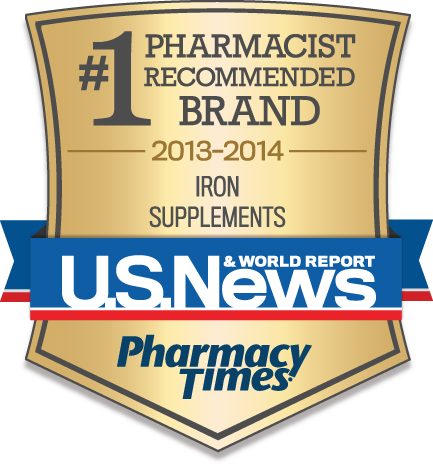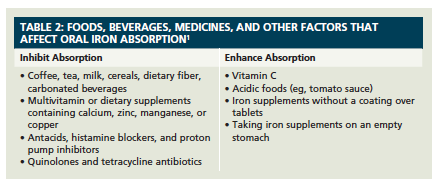Article
The Importance of Iron and Use of Iron Supplements
Iron deficiency is the leading nutritional deficiency in the world and the most common cause of anemia in the United States.

What Is Iron?
Iron is a mineral critical for the growth of all cells.1 It is needed to help our red blood cells deliver oxygen to the rest of the body. Almost two-thirds of the body’s iron is found in hemoglobin, the protein in red blood cells.2 Iron deficiency is the leading single nutritional deficiency in the world,3 and the most common cause of anemia in the United States.4
Iron in Our Diet
There are 2 forms of dietary iron. Heme iron is better absorbed than non-heme iron.5,6 Heme iron is found in animal foods, such as red meats, fish, and poultry. Non-heme iron is found in plant-based foods, such as lentils, beans, and fortified cereals; it is the main source of dietary iron.1,5,7 The recommended dietary allowances (RDAs) for iron by age and sex are listed in Table 1.2
Are You at Risk of Iron Deficiency?
The main causes of iron deficiency are inadequate amounts of dietary iron, increased iron needs, poor absorption, and blood loss.1,7 People prone to iron deficiency include athletes, young women, pregnant women, seniors, and vegetarians. Athletes often have an increased need for iron due to intense exercise, which stimulates increased red blood cell production. Adolescent females often do not get sufficient iron from their diet to offset menstrual losses.8 Pregnancy increases the need for iron by the mother and the fetus. Dietary iron intake often decreases in seniors due to a poor diet. Vegetarians are at risk of iron deficiency because they only consume plant-based foods (ie, non-heme iron).2,7,9

Symptoms
Common symptoms of iron deficiency include fatigue, decreased performance at work or school, feeling cold or difficulty maintaining adequate body temperature, impaired immune functioning, shortness of breath, and chest pain.7,10 Fatigue is the most common symptom; however, it may not be associated with iron deficiency anemia, as many diseases, conditions, or lifestyle choices may influence fatigue. Some individuals with iron deficiency may experience no symptoms.8 A blood test and a doctor’s assessment are recommended to properly diagnose iron deficiency.1,9
Diagnosing Iron Deficiency
If you have any of the symptoms described above or are concerned about getting enough iron, speak to your physician. Only they can determine if you have iron deficiency anemia. The 2 most common blood tests for iron deficiency anemia assess hemoglobin and hematocrit (the percentage of red blood cells in the total volume of blood). Additionally, a physician may order a complete blood count to determine the total number of red blood cells and a test for your serum ferritin level (a protein in the body used to store iron).9 A physician must determine the cause of iron deficiency anemia and recommend the best treatment plan.1
Iron Supplements
Iron supplements may be used to treat iron deficiency anemia. It is important to take them as directed by your physician; the information below is provided to give you a better understanding of what you can expect from taking iron supplements and tips for taking them appropriately. A multivitamin is not often recommended as a treatment option because it may contain an insufficient amount of iron. Also, other minerals, such as calcium, phosphorus, and magnesium, can impair the absorption of iron.1
Numerous brands of oral iron supplements are available over the counter (OTC), and formulations include ferrous sulfate, carbonyl iron, and heme-based iron.11 The different formulations vary in absorption and side effect profiles, specifically gastrointestinal effects. The most common gastrointestinal side effects are nausea, constipation, and diarrhea. These side effects are generally dose related and can often be managed by dosage adjustment and symptom-specific remedies.1

Feosol Iron Supplements
Feosol offers 3 different formulas of iron OTC to fit every budget and lifestyle. The new Feosol packaging makes it easier to compare and select the type of iron for your needs. Each form of iron is absorbed differently by the body, depending on the individual.
• Feosol Original
- Contains ferrous sulfate iron
- Most common and economical form
It contains 65 mg of elemental iron, equivalent to a 325-mg tablet, which provides 360% of the RDA, making it a high-potency iron supplement.12
• Feosol Natural Release
- Contains carbonyl iron, a pure form of iron
- Gentle on the system
It does not require any additives or coating for gradual and gentle absorption of iron. This type of iron is naturally regulated by your body, which must produce gastric acid to help with the absorption. Many people find that this is a well-tolerated, milder alternative to other traditional forms of iron. It contains 45 mg of iron, which provides 250% of the RDA.12
• Feosol Complete with Bifera®
- Contains heme and non-heme iron
- Gentler on the system, minimizes side effects like constipation and nausea
It contains 28 mg of iron, 22 mg as a polysaccharide iron complex and 6 mg as a heme iron polypeptide, which provides 155% of the RDA. This formulation offers the convenience of being taken with or without food; because it includes heme iron, additives like vitamin C are not necessary to enhance absorption.12
Special Considerations When Taking Iron Supplements
Several foods, beverages, and other factors influence iron absorption, especially the non-heme form (Table 2).1,5 Oral iron products may interfere with the absorption of certain antibiotics, so they should not be taken within 2 hours of each other. Proton pump inhibitors affect vitamin C and its functions within the stomach; therefore, they may influence the bioavailability of iron.1,13
Speak with Your Pharmacist
You should not take iron supplements without first consulting a pharmacist or physician and receiving a diagnosis. Pharmacists can help in the selection of the best iron product/formulation and answer any questions. Always inform your pharmacist if you are taking any medications or other supplements, as they may influence the absorption of iron or specific medications.
WARNING:
Accidental overdose of iron-containing products is a leading cause of fatal poisoning in children under 6 years of age. Keep this product out of reach of children. In case of accidental overdose, call a doctor or poison control center immediately.
These statements have not been evaluated by the FDA. Feosol is not intended to diagnose, treat, cure, or prevent any disease.
References
- Alleyne M, Horne MK, Miller JL. Am J Med. 2008;121(11):943-948.
- Food and Nutrition Board. Institute of Medicine. Dietary Reference Intakes for Vitamin A, Vitamin K, Arsenic, Boron, Chromium, Copper, Iodine, Iron, Manganese, Molybdenum, Nickel, Silicon, Vanadium, and Zinc. Washington, DC: The National Academies Press; 2001. www.nap.edu/catalog.php?record_id=10026. Accessed March 26, 2013.
- Gautam CS, Saha L, Sekhri K, Saha PK. Medscape J Med. 2008;10(12):283.
- Centers for Disease Control and Prevention. MMWR Recomm Rep. 1998;47(RR-3):1-29.
- Hallberg L. Ann Rev Nutr. 1981;1:123-147.
- Ekman M, Reizenstein P. Z Ernahrungswiss. 1993;32(1):67-70.
- National Institutes of Health. Dietary Supplement Fact Sheet: Iron. http://ods.od.nih.gov/factsheets/iron. Accessed March 9, 2013.
- Umbreit J. Am J Hematol. 2005;78(3):225-231.
- World Health Organization. Iron deficiency anaemia: assessment, prevention, and control: a guide for programme managers. http://whqlibdoc.who.int/hq/2001/WHO_NHD_01.3.pdf. Accessed March 26, 2013.
- What is iron-deficiency anemia? National Heart, Lung, and Blood Institute website. www.nhlbi.nih.gov/health/health-topics/topics/ida/. Accessed April 1, 2013.
- Sobieraj DM. Heme or non-heme? an overview of iron supplements. Drug Store News. March/April 2010.
- Feosol website. www.feosol.com. Accessed March 12, 2013.
- McColl KE. Am J Gastroenterol. 2009;104(suppl 2):S5-S9.
Newsletter
Stay informed on drug updates, treatment guidelines, and pharmacy practice trends—subscribe to Pharmacy Times for weekly clinical insights.






